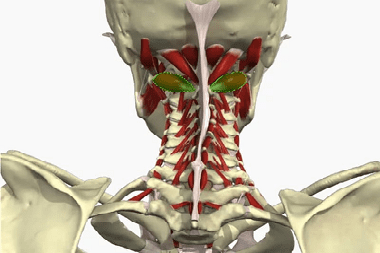Neurological diseases >>>> How does the occipital nerve hurt?
How does the occipital nerve hurt?

In neurological practice, there are often cases when a person treats with symptoms resembling myositis or myalgia of the occipital muscles, recurrent osteochondrosis of the neck, headache, but in fact we are talking about a lesion of the occipital nerve.
A person has four occipital nerves located symmetrically on either side of the cervical spine. The occipital nerves are an extension of the cervical nerves, intertwine with the muscles of the neck and head, and branch out in the occipital region.
What can happen to the occipital nerve? The occipital nerve can be pinched, cold, mechanically injured, which causes unbearable painful sensations in the neck, occiput and head. In whatever way the occipital nerve is injured, the result will be the same - it will become inflamed. It is the inflammation of the occipital nerve that is associated with the development of a number of pain sensations: headache, pulling pain in the back of the head, piercing pain in the neck and back of the head.
Diagnosis of occipital neuralgia (inflammation) is most accurately possible with MRI. For this reason, when referring to a neurologist, it is extremely important for a patient to describe pain in the neck and head as accurately as possible.
What you need to pay attention to in case of occipital nerve neuralgia, what signs of inflammation of the occipital nerve are characteristic:
- the main typical symptom is headache, which develops when turning the head, tension of the muscles of the cervical spine;
- pain is characteristic of one side of the head and / or neck (rarely symmetrical);
- acute pain, shooting character;
- pain can radiate (give) to the side of the lower jaw or behind the ear;
- increased visual sensitivity to light.
The causes of inflammation of the occipital nerve can be different:
- stretching of the neck muscles during exercise or excessive exertion,
- injuries to the muscles of the neck and occipital region of the head,
- hypothermia of the neck or back of the head (drafts),
- osteochondrosis of the cervical spine,
- complication after sore throat, flu, meningitis, encephalitis, tuberculosis or other infectious diseases,
- prolonged forced uncomfortable position of the head (neck tension) during sedentary work,
- rheumatic diseases of the spine in the cervical spine,
- autoimmune diseases associated with the destruction of nerve tissue.
How to treat inflammation of the occipital nerve?
There are conservative and surgical methods for treating occipital neuralgia. Conservative treatment involves the use of anti-inflammatory drugs (non-steroidal), muscle relaxants (relax the muscles that create additional compression of the occipital nerve), pain relievers (injections into the site of inflammation), warming up the cervical and occipital region.
Surgical intervention is required if it is impossible to restore the work of the affected occipital nerve by conservative methods and involves:
- the release of the occipital nerve from compression during infringement is carried out using decompression by microsurgical intervention,
- an extreme case - surgical transection of nerve fibers.

Read

Read



























